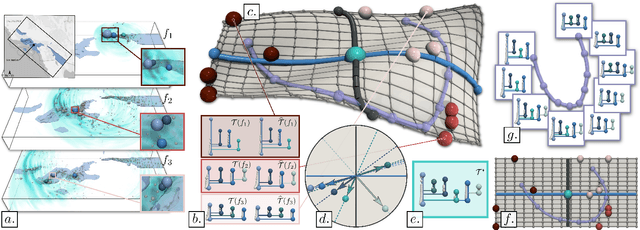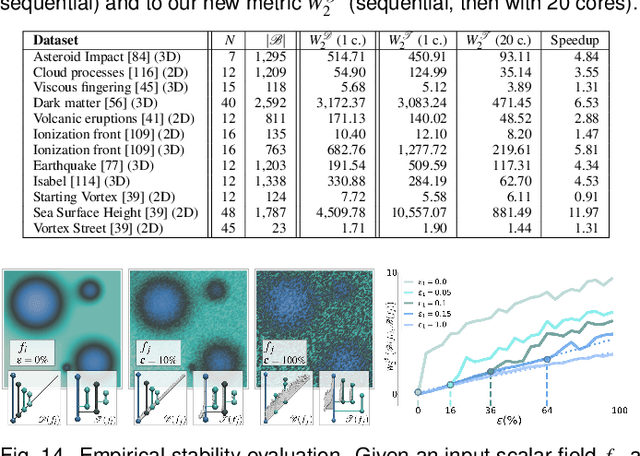Mathieu Pont
A Practical Solver for Scalar Data Topological Simplification
Jul 17, 2024



Abstract:This paper presents a practical approach for the optimization of topological simplification, a central pre-processing step for the analysis and visualization of scalar data. Given an input scalar field f and a set of "signal" persistence pairs to maintain, our approach produces an output field g that is close to f and which optimizes (i) the cancellation of "non-signal" pairs, while (ii) preserving the "signal" pairs. In contrast to pre-existing simplification algorithms, our approach is not restricted to persistence pairs involving extrema and can thus address a larger class of topological features, in particular saddle pairs in three-dimensional scalar data. Our approach leverages recent generic persistence optimization frameworks and extends them with tailored accelerations specific to the problem of topological simplification. Extensive experiments report substantial accelerations over these frameworks, thereby making topological simplification optimization practical for real-life datasets. Our approach enables a direct visualization and analysis of the topologically simplified data, e.g., via isosurfaces of simplified topology (fewer components and handles). We apply our approach to the extraction of prominent filament structures in three-dimensional data. Specifically, we show that our pre-simplification of the data leads to practical improvements over standard topological techniques for removing filament loops. We also show how our approach can be used to repair genus defects in surface processing. Finally, we provide a C++ implementation for reproducibility purposes.
Principal Geodesic Analysis of Merge Trees (and Persistence Diagrams)
Jul 22, 2022



Abstract:This paper presents a computational framework for the Principal Geodesic Analysis of merge trees (MT-PGA), a novel adaptation of the celebrated Principal Component Analysis (PCA) framework [87] to the Wasserstein metric space of merge trees [92]. We formulate MT-PGA computation as a constrained optimization problem, aiming at adjusting a basis of orthogonal geodesic axes, while minimizing a fitting energy. We introduce an efficient, iterative algorithm which exploits shared-memory parallelism, as well as an analytic expression of the fitting energy gradient, to ensure fast iterations. Our approach also trivially extends to extremum persistence diagrams. Extensive experiments on public ensembles demonstrate the efficiency of our approach - with MT-PGA computations in the orders of minutes for the largest examples. We show the utility of our contributions by extending to merge trees two typical PCA applications. First, we apply MT-PGA to data reduction and reliably compress merge trees by concisely representing them by their first coordinates in the MT-PGA basis. Second, we present a dimensionality reduction framework exploiting the first two directions of the MT-PGA basis to generate two-dimensional layouts of the ensemble. We augment these layouts with persistence correlation views, enabling global and local visual inspections of the feature variability in the ensemble. In both applications, quantitative experiments assess the relevance of our framework. Finally, we provide a lightweight C++ implementation that can be used to reproduce our results.
Wasserstein Distances, Geodesics and Barycenters of Merge Trees
Jul 16, 2021



Abstract:This paper presents a unified computational framework for the estimation of distances, geodesics and barycenters of merge trees. We extend recent work on the edit distance [106] and introduce a new metric, called the Wasserstein distance between merge trees, which is purposely designed to enable efficient computations of geodesics and barycenters. Specifically, our new distance is strictly equivalent to the L2-Wasserstein distance between extremum persistence diagrams, but it is restricted to a smaller solution space, namely, the space of rooted partial isomorphisms between branch decomposition trees. This enables a simple extension of existing optimization frameworks [112] for geodesics and barycenters from persistence diagrams to merge trees. We introduce a task-based algorithm which can be generically applied to distance, geodesic, barycenter or cluster computation. The task-based nature of our approach enables further accelerations with shared-memory parallelism. Extensive experiments on public ensembles and SciVis contest benchmarks demonstrate the efficiency of our approach -- with barycenter computations in the orders of minutes for the largest examples -- as well as its qualitative ability to generate representative barycenter merge trees, visually summarizing the features of interest found in the ensemble. We show the utility of our contributions with dedicated visualization applications: feature tracking, temporal reduction and ensemble clustering. We provide a lightweight C++ implementation that can be used to reproduce our results.
 Add to Chrome
Add to Chrome Add to Firefox
Add to Firefox Add to Edge
Add to Edge